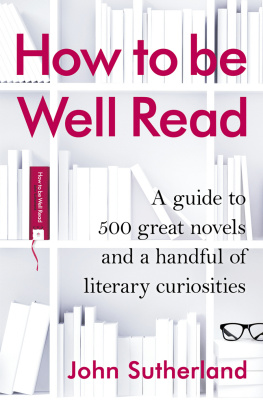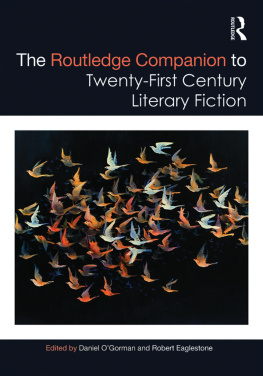Conversations with Theron Britt and Paul Naylor helped shed light on many of the dark corners in Underworld. Thanks for your insights and friendship. And to my wife, Kathy Schroth, what can I say? She knows where my obsessions dwell.
Portions of Chapter 2 draw on my essay "Baseball as Aesthetic Ideology: Cold War History, Race, and DeLillo's 'Pafko at the Wall,' " which appeared in Modem Fiction Studies (Summer 1995). An expanded version of this essay was reprinted in Critical Essays on Don DeLillo (G. K. Hall, 2000), edited by Hugh Ruppersburg and Tim Engles. My thanks to these editors and publishers for permission to use this material here.
The Novelist
BACKGROUNDS
In the spring of 1999, the announcement came from Israel that Don DeLillo had won the Jerusalem Prize. The award, given every two years since 1963, honors a writer whose body of work expresses the theme of the individual's freedom in society. On June 23, 1999, he was honored in a ceremony at the Jerusalem International Book Fair. As the first American recipient of the award, DeLillo joins an international group of distinguished novelists, playwrights, and philosophers that includes Bertrand Russell, Simone de Beauvoir, Jorge Luis Borges, Eugene Ionesco, V. S. Naipaul, Milan Kundera, and Mario Vargas Llosa. In selecting DeLillo, the jury characterized his work as "an unrelenting struggle against even the most sophisticated forms of repression of individual and public freedom during the last half century" (19th Jerusalem). The prize signals the canonical status DeLillo's work has begun to achieve in the last decade. DeLillo, in fact, has established himself as one of the leading American candidates for the Nobel Prize for Literature.
Winning this prize, though, may prove more difficult, since the Nobel usually is given to those authors who write about the human heart in conflict with itself and not to one such as DeLillo who so directly challenges the legitimacy of multinational capitalism and its manipulation of the image through media and advertising to construct first-world identity via the individual's acts of consumption. In Underworld, however, DeLillo may have succeeded in wedding his cultural critique to characters with fully developed inner lives that recall an older novelistic sense of the human heart.
Whether DeLillo eventually wins the Nobel, his lasting place in American literature at present seems certain, an unlikely achievement for someone who started life as the child of Italian immigrant parents. (DeLillo's father came to America in 1916 when he was nine years old and eventually worked his way up to a position as an auditor for a life insurance company.) Born on November 20, 1936 in New York, Donald Richard DeLillo experienced an ethnic childhood in a working-class North Bronx neighborhood. Yet after his apprentice short stones of the 1960s, any representation of his ethnicity simply drops out of his fiction from Americana (1971) through Mao II (1991). As one critic noted in 1990, DeLillo's "name could just as well be Don Smith or Don Brown" since there's "nothing particularly 'ethnic' about his dark comedy" (Aaron 68). It is precisely DeLillo's recovery of his ethnic roots that marks Underworld as his most personal work to date. As DeLillo notes, it was only in reading the galleys for Underworld, with its representation of 1950s Italian-American Bronx life, that he realized he was "reliving experience" through his central character, Nick Shay (whose mother reverts to her Irish maiden name after his father, Jimmy Costanza, disappears), "in a curious and totally unintentional way"; elaborating, DeLillo says,
When I first started writing I wrote short fiction, short stories set mostly in [the Bronx ] and when I finally got to work on my first novel, Americana the title itself says somethingthis was a kind of journey into the broader culture. A curious unintentional form of repetition of my own parents' journey, my immigrant parents who came to the U.S. from Italy . This was their way out of a certain narrowness, an economic narrowness, into a country that promised certain things.
When I was in my early 20s maybe that background and those narrow streets seemed to be a bit constricting in terms of what I could get out of them as a writer because I hadn't yet developed a perspective, a maturity as a writer. (Echlin)
DeLillo's comments, in which he effectively claims his maturity as a writer, allow a new perspective from which to see his earlier life. His repeated use of the word "unintentional" in relation to Underworld underscores the fact this novel contains more autobiographical elements than any of his previous fiction. In addition to the character Nick Shay, Albert Bronzini also serves as an angle of vision that allows DeLillo to recapture the neighborhood of his youth. Bronzini, the artist manqu, who even thinks "walking was an art" (661), strolls through the Italian neighborhood in the opening chapter of Part 6, processing the details of the street scenes with a finely honed aesthetic consciousness.
Catholicism was a part of DeLillo's Italian-American upbringing, an aspect he has acknowledged: "I think there is a sense of last things in my work that probably comes from a Catholic childhood. For a Catholic, nothing is too important to discuss or think about, because he's raised with the idea that he will die any minute now and that if he doesn't live his life in a certain way this death is simply an introduction to an eternity of pain" (Passaro, "Dangerous"). Despite Catholicism's looming threat of eternal damnation, DeLillo was drawn to Church rituals, such as high funeral masses, calling them some of his "warmest childhood memories"; moreover, DeLillo sees a link between religious ritual and art; he notes that Catholic "ritual had elements of art to it and it prompted feelings that art sometimes draws out of us. I think I reacted to it the way I react today to theater." (LeClair, 26).
In the early 1950s, DeLillo would later discover, he lived just a half dozen blocks from his near contemporary, Lee Harvey Oswald. Although the two never met, this proximity inspired DeLillo to write his ninth novel, Libra (1988), a novel that challenges the Warren Commission Report's assertion that Oswald acted alone in assassinating President Kennedy. After graduating form CardinalHayesHigh School in the Bronx, DeLillo attended FordhamUniversity, a Jesuit institution, from 1954 to 1958 earning a B.A. in "something called communication arts." At Fordam, DeLillo claims, "the Jesuits taught [him] to be a failed ascetic" (Harris). (In Underworld, Nick Shay, after attending reform school run by Jesuits, attends a college in rural Minnesota that is an experimental satellite program administered by Fordam.)
In 1959, DeLillo took a position as a copywriter for Ogilvy and Mather, an advertising agency. This work experience finds expression in Underworld's portrayal of Madison Avenue office culture in Chapter 2 (the "December 19, 1961" fragment) of Part 5, where we see Charles Wainwright's soul-killing work of constructing aesthetically pleasing misrepresentations of orange juice. While working for Ogilvy and Mather, DeLillo began to write fiction. His first published story, "The River Jordan," appeared in Epoch in 1960. By 1964, DeLillo had his fill of corporate American and quit his job to become a freelance writer. Recalling this time, DeLillo says, "I did all sorts of assignments. One day I would be writing about pseudo-colonial furniture, the next day about computers." (Goldstein, 56). Such assignments supplied barely enough income to pay the rent on a studio apartment in the Murray Hill section of New York while he continued to publish the occasional short story in various literary magazines. As a struggling young writer, DeLillo lived a spartan existence, earning only around $2000 a year. In 1966 he began work on what would become his first novel,




